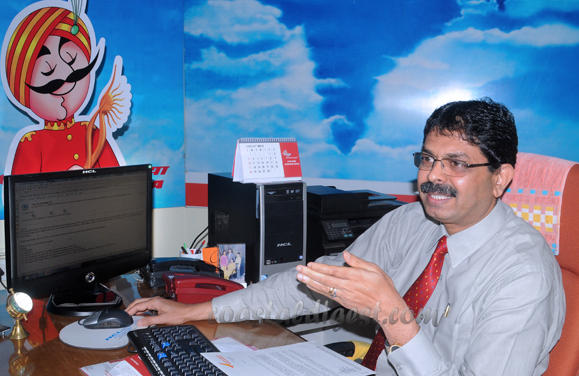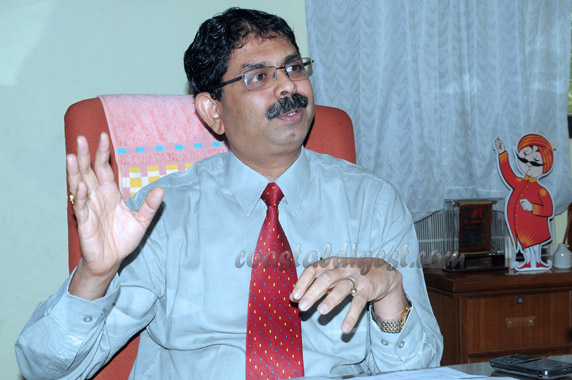The longstanding demand of over lakhs of expatriates from South West Coast of India living in the Eastern Province of Kingdom of Saudi Arabia has been realised by India’s very own public sector aviation company- Air india Express, which has come forth to start a direct flight between Mangalore and Dammam from April 3, 2013. As the flight ushers in sense of euphoria among the expats, here are some excerpts from the exclusive interview with Air India Express Mangalore station manager Melwin D’Silva.

What can Mangaloreans and NRIs in Saudi Arabia expect from Mangalore-Dammam flight service being introduced by Air India Express? Are there any inaugural packages on offer for passengers in this new service?
Air service between Mangalore and Saudi was a very sought after connection for a long time. The Mangalore-Dammam flight will operate on Wednesdays and Saturdays. The return flight will be on Thursday and Sunday morning. It will be a non-stop direct flight. We have placed reasonable prices for the service. Considering the present and past experience, Air India Express is doing very well. The on-time performance of our airlines from Mangalore is more than 90-95%.
Basically Air India Express is a Point A to Point B kind of a carrier. What the passengers can look at is the low cost model of the airline. In spite of being a low cost carrier, we provide passengers with on-board food like a normal full service carrier. This will be an opening service for passengers of Mangalore and other parts of the coastal region including that of Kerala. Earlier people would have to go via Bombay which was more expensive and more time consuming. These are some features the passengers can definitely look forward to.
Is the airline ready for the challenges ahead in terms of the longer journey duration that the aircraft will have to cover?
All possible aspects are looked at before introducing a flight. We will not put a flight where the endurance of the aircraft does not match with the journey distance. Yes, on the Mangalore-Dammam route, since there will be greater fuel consumption, you might come across situations where we might be accepting passengers lesser than the actual capacity. There is a minimum ‘fuel upliftment’ which is calculated in a journey between two destinations, looking at the flying hours. In a Mangalore-Bombay journey, the fuel consumption is less. So the ‘fuel upliftment’ there will be lesser. When there is longer duration journey, there is greater fuel consumption and also keeping in mind factors like diversions etc, we calculate a minimum fuel upliftment. So situations may arise where this load may have an impact on the passenger load.
What measures have been thought of to ensure safety of passengers?
Each and every part of the aircraft is closely monitored. There are daily inspections and weekly inspections. For instance, take the tyre of the aircraft, there are so many regulations in place to ensure that the tyre is replaced irrespective of whether it is in good condition or bad condition. Similarly each and every part of the aircraft is regularly checked. Aviation industry is one industry where safety norms are thoroughly followed. There is no compromise here. Air India being a national carrier, safety is most important for us. We will not fly an aircraft which is not up to the mark. The pilots are careful and we also take care of them, making sure that their job is not at stake.
Are you introducing a new aircraft for the Mangalore-Dammam sector or pressing one of your existing aircrafts into this service?
There is nothing called an ‘old aircraft’ in aviation terminology because they are all ‘air worthy’. Like I said, each and every part is regularly checked and monitored. The fleet of Air India aircrafts is very young. All our aircrafts are of a younger fleet with an average age of less than five to six years. We have the latest 321s, the 319s, the 787s and the likes.
Can we expect the ‘Dreamliner’ to also start operating in Mangalore soon?
Currently, the Mangalore Airport has got a limitation. It can handle aircrafts like the Airbus 310 which it did recently. The limitations might be a constraint at the moment. ‘Dreamliner’ is not a jumbo aircraft as such. It is a Boeing 787. But it is technologically advanced. People who have flown the ‘Dreamliner’ have come back and said that it is one of the best aircrafts they have flown.
NRIs are ecstatic at the fact that direct flight service between Mangalore and Dammam has become a reality. Are there plans of connecting Mangalore directly to other Saudi cities like Jeddah and Riyadh in the pipeline?
We will take one step at a time. Yes, definitely Air India Express is looking at Mangalore in a big way. Starting of a new sector brings with it many factors which have to be looked into, whether there is availability of aircrafts, whether there are enough pilots, the potential of the route, besides others. Only after looking at all these things do we decide on finalizing a route. If we find connecting Mangalore directly to Jeddah or Riyadh will be potentially beneficial, we will certainly go ahead.
How is the Dubai sector working for Air India now, especially after Jet Airways began operations between Mangalore and Dubai as an alternate service?
The Dubai sector is doing very well. We have double daily flights from Mangalore to Dubai. Passengers are getting good fares on the Dubai sector with us. Fares as low as Rs. 7,000 are also available with us to Dubai. There is the morning flight and the evening flight so the passenger has the option to decide on the timing of his journey. I have received feedback from passengers on many occasions saying that they still prefer Air India Express. Passengers say that when Air India Express lands in Dubai, the formalities are completed at faster pace and they are out of the airport within 15-20 minutes. Whereas the other full service carrier lands at the normal terminal and it takes more time for the formalities to complete. So people are happy and I have heard them say that we tried the alternate service but we prefer Air India Express. We have not lost ground. We continue to maintain our hold on the Dubai sector.
How is the Air India looking at the coming up of Air Cargo complex at Mangalore International Airport?
There is tremendous potential in cargo as well. Since Mangalore is so well connected to the Middle East with direct flights, definitely we have a good export-import movement on the cargo sector. Nothing connects Mangalore to Middle East better than Air India. So we will surely look at this new avenue with a business perspective.







Comments
Add new comment